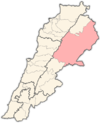Younine
يونين | |
|---|---|
| Coordinates: 33°38′53″N 35°53′10″E / 33.64806°N 35.88611°E | |
| Country | Lebanon |
| Governorate | Baalbek-Hermel |
| District | Baalbek |
| Area | |
| • Total | 7,759 ha (19,173 acres) |
| Elevation | 1,215 m (3,986 ft) |
Younine (Arabic: يونين, romanized: Yūnīn), also spelled Yunin, is a municipality in the Baalbek District of the Baalbek-Hermel Governorate in northeastern Lebanon.[1] It is located approximately 103 kilometers (64 mi) east of the national capital Beirut,[1] and 18 kilometers (11 mi) northeast of the governorate capital of Baalbek.[2] Its average elevation is 1,215 meters (3,986 ft) above sea level and its jurisdiction covers 7,759 hectares.[1] It had 6,557 registered voters in 2010. Its inhabitants are Shia Muslims.[3]
History
Younine was the ancestral village of the 13th-century Mamluk hadith scholars Abd Allah al-Yunini (d. 1220) and Qutb al-Din Musa ibn Muhammad al-Yunini al-Hanbali of Damascus. Qutb al-Din also owned a residence in the village. At the time Younine also contained a Sufi lodge.[4] The archer Husayn al-Yunini also hailed from Younine.
In 1838, Eli Smith noted Yunin as a Metawileh village in the Baalbek area.[5]
References
- ^ a b c "Younine". Localliban. 7 December 2007. Retrieved 30 September 2020.
- ^ Mune: La conservation alimentaire traditionnelle au Liban (in French). Paris: Éditions de la Maison des sciences de l'homme. 1994. p. 6. ISBN 9782735105397.
- ^ "Municipal and ikhtiariah elections in the Beqa'a 147 municipalities and 414 mokhtars" (PDF). The Monthly Magazine. February 2010. pp. 18, 21. Archived from the original (PDF) on 2016-03-04.
- ^ Guo, Li (1998). Early Mamluk Syrian Historiography: Al-Yūnīnī's Dhayl Mirʼāt al-zamān, Volume 1. Leiden. pp. 6–7, 9, 14. ISBN 90-04-11028-3.
{{cite book}}: CS1 maint: location missing publisher (link) - ^ Robinson and Smith, 1841, vol 3, 2nd appendix, p. 145
Bibliography
External links
- Younine, localiban


